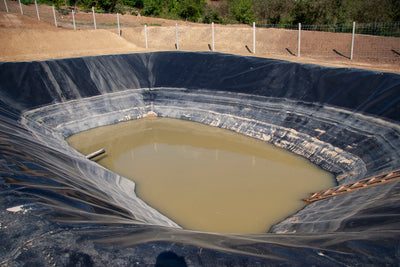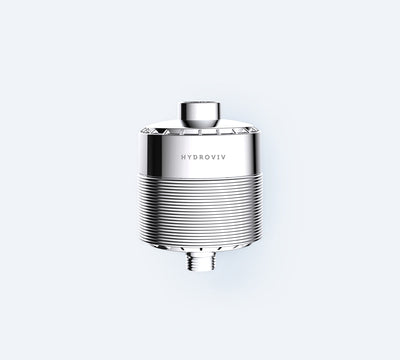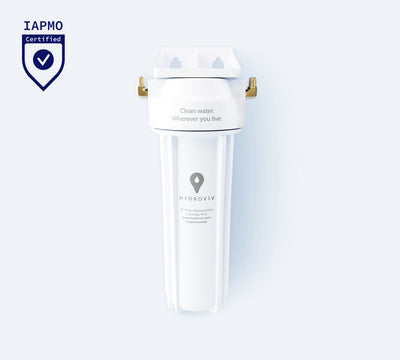Drinking Water Supplies Risk Contamination from Toxic Wastewater Ponds
RSS
Christina Liu | Hydroviv Science Team
The leaking phosphogypsum waste pond that nearly collapsed in Florida highlights the dangers and near-disasters associated with wastewater ponds throughout the country. These toxic ponds are not only created from phosphate mining, but used at power plants (coal ash) and large-scale agricultural facilities. For these reasons, waste ponds significantly threaten both public and private drinking water supplies.
What Are Waste Ponds?
Waste ponds are open-air reservoirs that contain a variety of different types of industrial and agricultural waste. including at least 70 phosphogypsum stacks (from phosphate mines used for fertilizer production), over 700 coal-ash ponds near coal-burning power plants, and thousands of manure lagoons near livestock farms and other agricultural facilities.
Phosphogypsum, or gypsum, is the radioactive leftover waste from the mining process. There's currently no safe way to dispose of it, so mining companies dump the waste into man-made hills called "phosphogypsum stacks."
Livestock farms have traditionally stored manure in lagoons adjacent to the farms to then be reused as fertilizer for corn grown and used as feed for the livestock. However, large industrial farms now typically use synthetic fertilizers to grow corn, so they no longer reuse the manure, but just collect the waste into the lagoons.
Coal-fired plants produce coal ash, which is the residue produced from burning coal. Coal ash is stored in open air waste pools at hundreds of power plants throughout the country.
How Do Waste Ponds Threaten Drinking Water?
Drinking water comes from surface water and groundwater. Toxic contaminants enter these sources through leaks in containment ponds, spills from structural failures, and ponds overflowing their banks from natural disasters such as flooding and hurricanes.
D’Ann Williams is a researcher for the Center for a Livable Future at the Johns Hopkins Bloomberg School of Public Health. She said that these ponds, many of which are unlined, pose a risk of leaching into the groundwater.
In a recent New York Times article, Ms. Williams stated that “gases also come off the lagoons, or crusts can form on top, trapping the gas and then releasing bursts of hydrogen sulfide or ammonia, both affecting air quality in the area.”
“And when you have flooding and you can’t manage the amount of water that’s coming in, you can end up with the bacteria, and chemicals, in the surface water, and on the land,” Ms. Williams said.
Coal ash contains contaminants like mercury, cadmium and arsenic. Phosphogypsum waste also contains arsenic and cadmium, as well as lead, chromium, radium, and uranium. Without proper management, these contaminants can pollute waterways, ground water, drinking water, and the air.
Contaminants such as antibiotics, estrogens, bacteria, pesticides, heavy metals, and protozoa from manure lagoons endanger both surface and groundwater supplies if the contents overflow, or if there are leaks in the pits.
In Florida, a leak in the phosphogypsum waste pond caused the walls of the phosphogypsum stacks to shift. As a result, the collapse of the seven-story tall waste pond was imminent, which would have been destructive and catastrophic to the residents living nearby. Officials had to issue an emergency mandatory evacuation order to 300 homes in the vicinity. This disaster was only averted when millions of gallons of contaminated wastewater from the pond was dumped into Tampa Bay. The ramifications of the release of the waste contaminants into the surface water in the area are yet to be fully understood.
Are Waste Ponds Currently Regulated?
The EPA enacted regulations in 2014 that aimed to address the risks from coal ash disposal, such as contaminating the groundwater, air, and the catastrophic failure of coal ash retention ponds.
A bill was proposed in April 2021 to increase coal ash regulations and restore protections removed by the Trump Administration. Some protections include requiring power plants to pay for cleanup costs, prohibiting unlined waste ponds, and requiring regulatory oversight of coal ash facilities. The bill would also prevent coal ash ponds from being located near groundwater and increase public participation and protection for disadvantaged communities.
What Can I Do To Protect Myself from Water Contamination?
Water treatment plants alone aren’t necessarily sufficient to protect you from the contaminants present in these toxic waste pools. In addition, when disasters occur, water treatment facilities may become overwhelmed with the level of contaminants in the water, so you will want to consider using a filter at your point of use.
However, not all filters are effective at removing these contaminants. You will want a filter that is demonstrated effective for filtering contaminants including arsenic, lead, radium, and uranium. If nitrates are your primary concern, a reverse osmosis filtration system will remove it from your drinking water.
How Can Hydroviv Help Me?
Hydroviv is a water filtration company that uses water quality data to optimize water filters for each customer's water. For water systems that are near industrial and agricultural waste ponds, we include specialized filtration media to remove the contaminants of concern, which may include lead, arsenic, radium, and uranium. In addition, all of our filters include broad protection against a wide range of contaminants.
If you’re interested in learning more about water filters that have been optimized for your location, or have questions about water quality in general, feel free to visit www.hydroviv.com, reach out by email (hello@hydroviv.com) or through our live chat on our website Hydroviv.com. Also check out our water-related news on Twitter, Instagram, and Facebook.
Hydroviv's drinking water filters carry NSF certifications to Standard 42 (aesthetic effects--Chlorine Removal) and Standard 53 (health effects--Lead, VOCs, and PFOA/PFOS removal), and are independently tested to remove hundreds of contaminants.
Other Articles We Think You’ll Enjoy:Water Infrastructure and Cybersecurity
The American Jobs Plan To Allocate $111 Billion To Water Infrastructure Improvements
BPA and Phthalates: Are These Two Endocrine Disruptors in Your Water?




